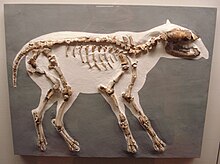This article needs additional citations for verification. (July 2023) |
Palaeotheriidae is an extinct family of herbivorous perissodactyl mammals that inhabited Europe, with less abundant remains also known from Asia,[3] from the mid-Eocene to the early Oligocene. They are classified in Equoidea, along with the living family Equidae (which includes zebras, horses and asses).[4]
| Palaeotheriidae | |
|---|---|

| |
| Palaeotherium magnum skeleton | |

| |
| Fossil of Plagiolophus | |
| Scientific classification | |
| Domain: | Eukaryota |
| Kingdom: | Animalia |
| Phylum: | Chordata |
| Class: | Mammalia |
| Order: | Perissodactyla |
| Superfamily: | Equoidea |
| Family: | †Palaeotheriidae Bonaparte, 1850 |
| Genera | |
| |
| Synonyms | |
|
Pachynolophidae Pavlow, 1888 | |
Morphology
editPalaeotheres ranged widely in size, from small species like Palaeotherium lautricense, which is estimated to have only weighed 36 kg (79 lb)[5] to large species like Palaeotherium magnum, which are comparable in size to living equines, with body masses over 200 kg (440 lb).[6] Their teeth are brachydont (low crowned).[7] According to Danilo et al. 2013., paleotheriids are distinguished from other equoids by one unambiguous synapomorphy "the nasal notch opening distally to the canine, above the postcanine diastema" and two unambiguous character state changes "an average metaconule on [the fourth premolar]" and "an oblique metastyle on [the first and second molars]".[8]
Taxonomy
editPalaeotheriidae is generally divided into the subfamilies Palaeotheriinae and ‘Pachynolophinae'. The two groups are distinguished by the morphology of their upper molars, with mesostyles being at least moderately developed in those Palaeotheriinae, but generally weakly developed or absent in those of 'Pachylophinae'. 'Pachylophinae' is controversial with regards to its definition and phylogenetic placement.[3] 'Pachylophinae', along with the genus Pachynolophus has been argued to be a paraphyletic group that is ancestral to Palaeotheriinae.[8][3]
Ecology
editEarly members of the family are suggested to have been frugivores, with later, larger members suggested to be browsers.[7]
Extinction
editEvidence suggests that palaeotheriids went extinct in Eurasia during the Early Oligocene, approximately 33 Ma, as part of a faunal turnover event known as the Grande Coupure. The Eocene-Oligocene transition marked a significant global cooling event caused by the onset of Antarctic glaciation. This resulted in drier and more open habitats dominating the early Oligocene, and the loss of the dense forests that characterised the Eocene epoch. This environmental change, coupled with the arrival of new and better-adapted mammalian groups from Asia, triggered a decline in endemic European mammal groups such as Palaeotheriidae and Anoplotheriidae. In the Hampshire Basin of southern England the last record of Palaeotheriidae is from the Lower Hamstead Mbr. of the Bouldnor Formation, dating to approximately 33.6 Ma.
Fossil distribution
edit- Creechbarrow Hill Site, Dorset, England
- Geiseltal, Mittelkohle, Zone III, Saxony-Anhalt, Germany
- Egerkingen, Alpha & Beta fissures, Baselland, Switzerland
- La Debruge, Provence-Alpes-Côte d'Azur Region, France
- The Caucasus Mountains in Georgia
See also
editReferences
edit- ^ Remy, Jean A.; Krasovec, Gabriel; Marandat, Bernard (2016). "A new species of Propalaeotherium (Palaeotheriidae, Perissodactyla, Mammalia) from the Middle Eocene locality of Aumelas (Hérault, France)". Palaeovertebrata. 40 (2): e1. doi:10.18563/pv.40.2.e1.
- ^ Perales-Gogenola, L.; Badiola, A.; Gómez-Olivencia, A.; Pereda-Suberbiola, X. (2023). "A remarkable new paleotheriid (Mammalia) in the endemic Iberian Eocene perissodactyl fauna". Journal of Vertebrate Paleontology. 42 (4): e2189447. doi:10.1080/02724634.2023.2189447. S2CID 258663753.
- ^ a b c Bai, Bin (November 2017). Hautier, Lionel (ed.). "Eocene Pachynolophinae (Perissodactyla, Palaeotheriidae) from China, and their palaeobiogeographical implications". Palaeontology. 60 (6): 837–852. Bibcode:2017Palgy..60..837B. doi:10.1111/pala.12319. ISSN 0031-0239.
- ^ Perales-Gogenola, Leire; Badiola, Ainara; Gómez-Olivencia, Asier; Pereda-Suberbiola, Xabier (2021-01-02). "New Leptolophus (Palaeotheriidae) species from the Iberian Peninsula and early evidence of hypsodonty in an Eocene perissodactyl". Journal of Vertebrate Paleontology. 41 (1). Bibcode:2021JVPal..41E2061P. doi:10.1080/02724634.2021.1912061. ISSN 0272-4634.
- ^ Remy, Jean-Albert (2015). "Les Périssodactyles (Mammalia) du gisement Bartonien supérieur de Robiac (Éocène moyen du Gard, Sud de la France)". Palaeovertebrata. 39 (1): 1–98. doi:10.18563/pv.39.1.e3.
- ^ MacLaren, Jamie A.; Nauwelaerts, Sandra (2020). "Modern tapirs as morphofunctional analogues for locomotion in endemic Eocene European perissodactyls". Journal of Mammalian Evolution. 27 (2): 245–263. doi:10.1007/s10914-019-09460-1.
- ^ a b Engels, Sandra; Schultz, Julia A. (June 2019). "Evolution of the power stroke in early Equoidea (Perissodactyla, Mammalia)". Palaeobiodiversity and Palaeoenvironments. 99 (2): 271–291. Bibcode:2019PdPe...99..271E. doi:10.1007/s12549-018-0341-4. ISSN 1867-1594.
- ^ a b Danilo, Laure; Remy, Jean A.; Vianey-Liaud, Monique; Marandat, Bernard; Sudre, Jean; Lihoreau, Fabrice (January 2013). "A new Eocene locality in southern France sheds light on the basal radiation of Palaeotheriidae (Mammalia, Perissodactyla, Equoidea)". Journal of Vertebrate Paleontology. 33 (1): 195–215. Bibcode:2013JVPal..33..195D. doi:10.1080/02724634.2012.711404. ISSN 0272-4634.